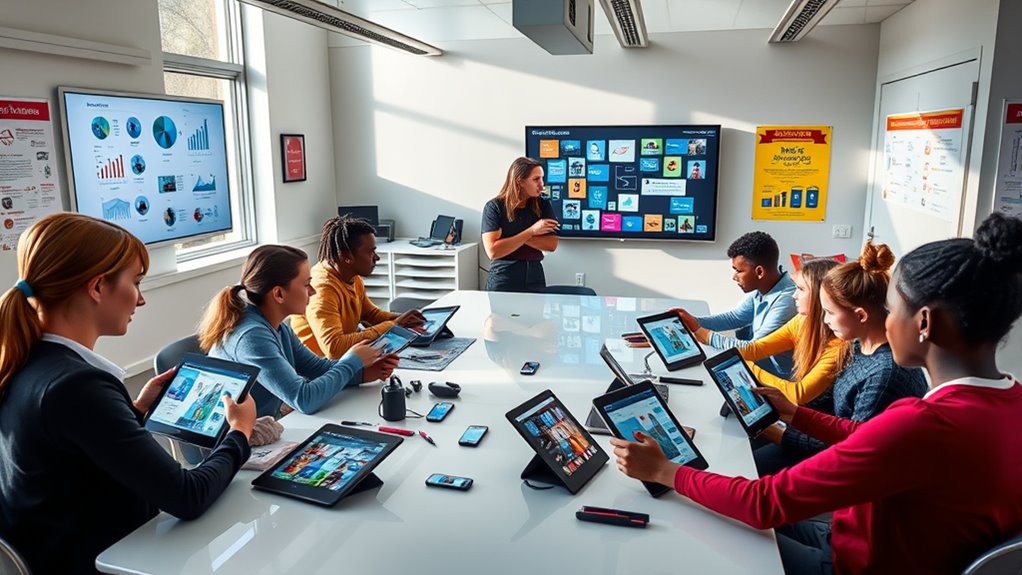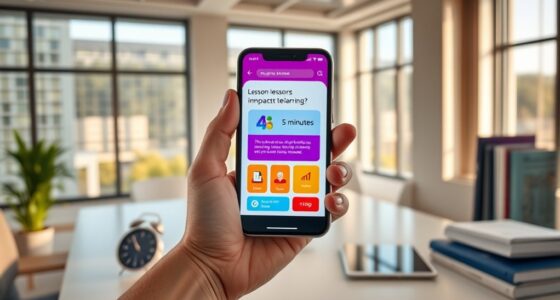To teach digital literacy and media skills, focus on helping students critically evaluate online content, recognize fake news, and understand social media influences. Encourage them to question sources, verify facts, and identify biases while discussing ethical online behaviors. Use real-world examples and active discussions to develop their skills. By fostering skepticism and responsible participation, you prepare students to navigate the digital world confidently. Keep going to discover effective strategies that make these lessons engaging and impactful.
Key Takeaways
- Incorporate lessons on identifying fake news and evaluating sources to foster critical thinking.
- Use real-world examples and case studies to illustrate digital and media literacy concepts.
- Teach students to recognize sponsored content and understand social media algorithms’ influence.
- Promote responsible sharing practices and ethical online behavior through discussion and reflection.
- Develop students’ ability to analyze diverse content critically and act as ethical digital citizens.

Have you ever wondered how to equip students with the skills they need to navigate an increasingly digital world? In today’s landscape, where information flows rapidly and sources are countless, teaching digital literacy is more essential than ever. A key component of this education involves helping students identify fake news and develop social media literacy. Fake news spreads quickly and can influence opinions, behaviors, and even elections. As an educator, your goal is to empower students to critically evaluate the information they encounter online, teaching them to question sources, verify facts, and recognize bias. This means guiding them beyond simply reading headlines to understanding the underlying motives and examining the credibility of the content. You might introduce activities that involve fact-checking exercises or analyzing news stories from multiple perspectives, helping students recognize false or misleading information.
Empower students to critically evaluate online information, identify fake news, and develop social media literacy skills.
Social media literacy plays a critical role in this process. Students spend hours scrolling through platforms like TikTok, Instagram, or Twitter, often encountering a mix of entertainment, advertisements, and news. However, they may not always understand how social media algorithms shape what they see or how their data is being used. By teaching social media literacy, you help them become aware of these mechanics and develop a critical eye for content. Encourage students to ask questions like: Who created this post? What is the purpose behind it? Could there be a hidden agenda? Teaching them to recognize sponsored content, filter out sensationalism, and distinguish between opinion and fact enhances their ability to consume media responsibly.
You can also incorporate practical strategies, such as promoting digital skepticism—urging students to pause before sharing or believing content—and fostering discussions about the ethical responsibilities involved in online interactions. Making students aware of the potential for misinformation to spread and the importance of responsible sharing helps build a more informed digital community. Integrating real-world examples and current events into lessons makes these skills more relevant and engaging. Use case studies of viral fake news stories or social media campaigns to illustrate how misinformation can influence public opinion.
Additionally, understanding the cost of electric bikes can help students appreciate the economic aspects of sustainable transportation and consider eco-friendly options in their communities. Ultimately, your role is to guide students toward becoming discerning consumers and responsible creators of digital content. By focusing on fake news and social media literacy, you prepare them not just to navigate the digital landscape safely, but to actively contribute to a healthier, more truthful online environment. Teaching these skills isn’t just about avoiding misinformation; it’s about empowering students to think critically, act ethically, and participate thoughtfully in the digital age.
Frequently Asked Questions
How Can Digital Literacy Be Integrated Into Early Childhood Education?
You can integrate digital literacy into early childhood education by using interactive storytelling and digital storytelling activities. Encourage children to create their own stories with simple digital tools, fostering creativity and understanding of media. Engage them in discussions about online content, teaching responsible use. Incorporate age-appropriate apps and devices to make learning fun, helping kids develop essential digital skills early on while nurturing their imagination and media literacy skills simultaneously.
What Are the Best Tools for Teaching Media Literacy to Teenagers?
Master media mastery with tools like interactive quizzes and social media analysis. You can engage teens by challenging their perceptions through quizzes that test media credibility, while social media analysis helps them identify bias and understand digital influence. These tools foster critical thinking, encourage active exploration, and make learning lively and relevant. Using these resources, you empower teens to navigate media confidently, cultivating both curiosity and competence in their digital worlds.
How Do Cultural Differences Affect Digital Literacy Education?
You should recognize that cultural differences influence digital literacy education through cross-cultural communication styles and varying media norms. When you understand these differences, you can avoid digital ethnocentrism, which can hinder engagement and learning. Adapting your teaching approach to respect diverse perspectives helps students connect better with content and peers worldwide. Emphasizing cultural awareness fosters inclusive digital literacy, empowering students to navigate global digital spaces confidently and responsibly.
What Are Common Challenges Teachers Face When Teaching Digital Skills?
You often face challenges like technological barriers, which can limit access to devices or reliable internet, making it hard to teach digital skills effectively. Student engagement also poses a problem; keeping learners interested requires dynamic approaches and relevant content. You must find creative ways to overcome these hurdles, ensuring all students develop essential digital literacy skills while maintaining motivation and participation throughout your lessons.
How Can Parents Support Digital Literacy Development at Home?
Think of digital literacy as a garden—your guidance helps it flourish. You can support your child’s growth by setting clear boundaries around screen time and encouraging meaningful online activities. Talk openly about online safety, teaching them to recognize risks and protect their privacy. By actively engaging in their digital world, you foster responsible habits, ensuring they develop the skills needed to navigate the internet confidently and safely.
Conclusion
By mastering digital literacy and media skills, you hold the power to navigate a world flooded with information—it’s like wielding a superhero’s shield against misinformation and manipulation. Every click, swipe, and share becomes a tool for truth or chaos. So, embrace these skills fiercely; they could be the difference between being lost in the digital chaos or reigning supreme with clarity and confidence. Your future depends on it—don’t let the digital domain overwhelm you!









